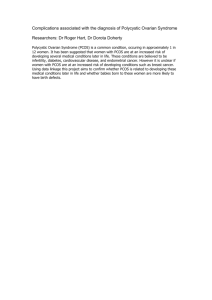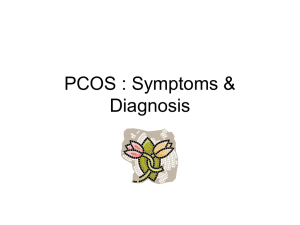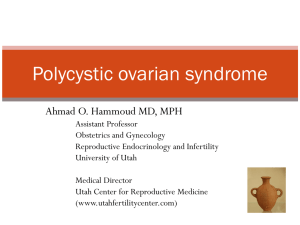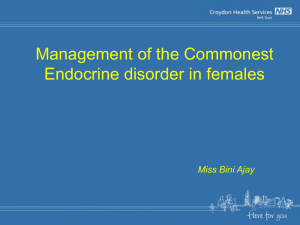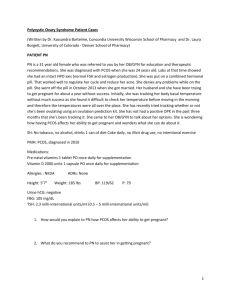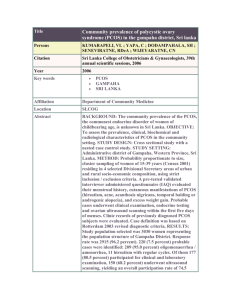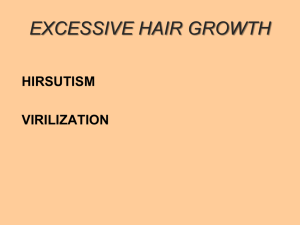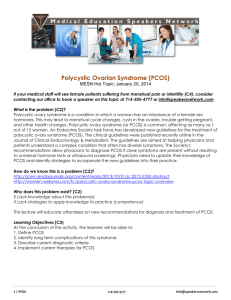2._Hyperandrogenism
advertisement
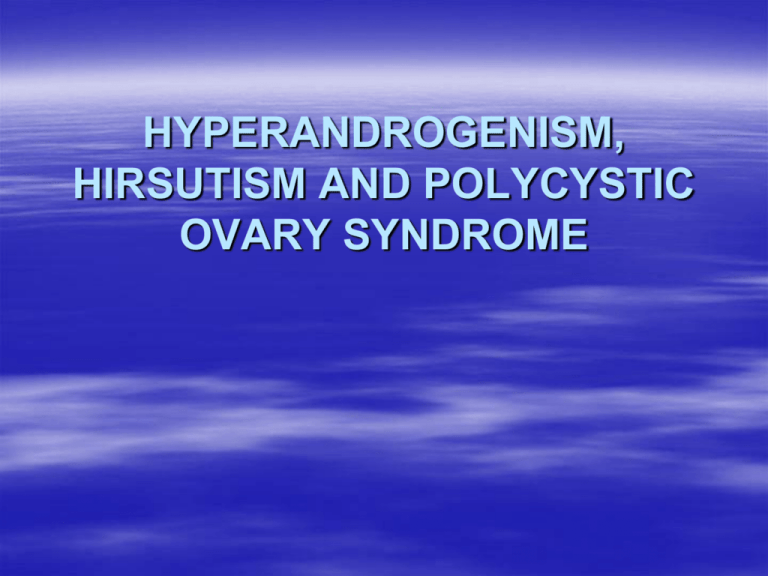
HYPERANDROGENISM, HIRSUTISM AND POLYCYSTIC OVARY SYNDROME hyperandrogenism is any clinical or laboratory evidence of androgen excess in women. The most common clinical presentation of hyperandrogenism in reproductive-aged women is hirsutism or acne with or without evidence of anovulation such as oligoamenorrhea - or amenorrhea or dysfunctional uterine bleeding. Elevated blood levels of androgens without clinical symptoms is referred to as cryptic hyperandrogenism. Hirsutism refers to the presence of course terminal hairs in androgen-dependent areas on the face and body in women. hypertrichosis, which is excessive growth of thin vellus hair at any body site. Hypertrichosis is usually familial or associated with endocrine disturbances such as anorexia nervosa or thyroid dysfunction, or with medications such as phenytoin, minoxidil or cyclosporin ). Hirsutism affects between 2-10% of women between the ages of 18 and 45. It is often a source of psychological discomfort and may be a sign of a significant medical disorder as will be discussed. causes The causes of hyperandrogenism in reproductive aged women can be divided into five categories in descending order of prevalence. . Causes of Hyperandrogenism Common Polycystic Ovary Syndrome Idiopathic Hirsutism Uncommon Late-Onset 21-Hydroxylase Deficiency1- Rare 80% 15% 5% < 1% Steroidogenic Enzyme Deficiencies 3b-hydroxysteroid dehydrogenase 17-ketosteroid reductase aromatasen Androgen Secreting Tumors of Ovary or Adrenal Ovarian Hyperthecosis (a PCOS variant) Other Endocrine Hyperprolactinemia Cushing syndrome Defects in cortisol metabolism Acromegaly Idiopathic Hirsutism Idiopathic hirsutism is excess terminal hair production in androgen dependent areas in the presence of regular ovulation and normal androgen levels It is the second most common cause of hirsutism after PCOS and occurs in about 15% of hirsute women. The pathophysiology of this disorder still needs to be fully elucidated, but is thought to be secondary to increased 5a-reductase activity in the skin or its appendages, to other alterations in androgen metabolism or to increased sensitivity of the androgen receptor Polycystic Ovary Syndrome PCOS is the most common cause of hirsutism and the most common endocrinopathy in reproductive aged women. It has a prevalence of about 5% in Caucasian and African Americans and in European populations (8-10 %). Adrenal and Ovarian Steroidogenic Enzyme Deficiencies Adrenal or ovarian steroidogenic enzyme deficiencies are the most common cause of hyperandrogenism in post-menarcheal women after PCOS and idiopathic hirsutism. Nevertheless these conditions are uncommon to very rare. Late-onset 21hydroxylase deficiency occurs in 1-5% of hirsute women, with the greatest prevalence in women of Askenazi Jewish descent Ovarian and Adrenal Tumors Both adrenal adenoma and carcinoma may present with virilization and hyperandrogenemia . Androgen secreting ovarian tumors include Sertoli-Leydig cell tumors, Leydig cell tumors, lipoid or lipid cell tumors and granulose-theca cell tumors Typically women with androgen secreting tumors have abrupt onset of symptoms distinct from menarche and a more rapid progressions of symptoms compared to PCOS. Signs of virilization such as clitoromegaly, frontal balding and deepening of the voice are also more common. Testosterone levels are usually greater than 200 ng/dl or 2 1/2 times the upper limit of normal, but there is clearly overlap between testosterone levels found in tumors and those seen in severe cases of PCOS or hyperthecosis, If a tumor is suspected, both ovarian ultrasound and adrenal CT scan should be done to localize it Other Endocrine Disorders Cushing syndrome and acromegaly. However hirsutism is usually not the primary complaint in these disorders. Prolactin should be determined in all patients with anovulation. Cushing syndrome can be ruled out by a normal 24 hour urinary cortisol or normal overnight dexamethasone suppression test . If there is any suspicion of acromegaly, a somatomedin-C level (IGF-I) and/or growth hormone suppression test should be done. POLYCYSTIC OVARY SYNDROME PCOS is the most common endocrinopathy in women and is the most common cause of androgen excess, affecting about 5% of reproductive aged women. Although androgen excess in women has been recognized since the time of Hippocrates and had been described in association with diabetes in the nineteenth century Pathophysiology of Polycystic Ovary Syndrome PCOS is a complex, heterogeneous disorder. It is likely genetic, environmental factors contribute to its pathophysiology, and that no single gene mutation will be found that is both necessary and sufficient to cause PCOS. The familial clustering that occurs in PCOS is consistent with a genetic susceptibility. About 50% of sisters of PCOS probands have hyperandrogenemia with or without anovulation, which suggests an autosomal dominant inheritance for a factor predisposing to ovarian hyperandrogenism Rotterdam Criteria (2 out of 3) – Menstrual irregularity due to anovulation oligoovulation – Evidence of clinical or biochemical hyperandrogenism – Polycystic ovaries by US presence of 12 or more follicles in each ovary measuring 2 to 9 mm in diameter and/or increased ovarian volume The etiology of anovulation in PCOS is often explained by high intraovarian androgen levels which induce atresia and prevent the emergence of a dominant follicle The ovarian hyperandrogenism of PCOS is gonadotropin dependent, and gonadotropin suppression with sex steroid or GnRHa results in normal androgen levels . It has been reported that 75% of women with clinical evidence of PCOS have an elevated LH level and 94% have an increased LH/FSH ratio . These gonadotropin secretory abnormalities have been thought to play an important role in the development of the ovarian hyperandrogenism characteristic of PCOS US 25% of normal ovulating women would have polycystic-appearing ovaries Ovaries will have a typical appearance of enlarged subcapsular small follicles(<10 mm ) The ovarian volume in women with PCOS is >10 cm3 &the normal range is 4.7 -5.2 cm3 Treatment of Polycystic Ovary Syndrome As PCOS is found in a large proportion of the female population, treatment is only required for the patient's symptoms. 1- Amenorrhoea Either induce ovulation which will result in regular menstruation (see below), or protect the endometrium against the effects of unopposed oestrogen stimulation by: • using the oral contraceptive pill which will result in regular menses • giving progestogens three or four times per year to induce endometrial shedding. If a patient has been anovulatory for more than a year, an endometrial biopsy is recommended before instituting therapy. The oral contraceptive pill (OCP) is an excellent choice, as it both inhibits endometrial proliferation and reduces ovarian androgen production, thus ameliorating the consequences of hyperandrogenism Insulin-sensitizing drugs may also decrease the risk of endometrial cancer in PCOS by lowering insulin levels and increasing the frequency of ovulation Although a moderate degree of insulin resistance and hyperinsulinemia is neither necessary nor sufficient to cause PCOS, it plays an important role in the pathogenesis of ovarian hyperandrogenism in many cases of PCOS. Both in vitro and in vivo evidence suggests that hyperinsulinemia contributes to excessive ovarian androgen production in PCOS. 2-Obesity Weight reduction has many benefits for the patient but usually proves very difficult. Once considerably overweight, patients become less active and their basal metabolic rate (BMR) is reduced, thus they require less calories to maintain their body weight. 3-Treatment of Hirsutism Medical Therapy The aim of medical therapy is to suppress androgen production, block androgen receptors or decrease the conversion of testosterone to dihydrotestosterone by inhibition of the enzyme 5a-reductase Medical treatment of Hirsutism Oral Contraceptive Pills - OCPs have commonly been used to treat patients with hirsutism and other signs of androgen excess. The progestational component of the OCP inhibits pituitary secretion of LH, which in turn decreases ovarian androgen production. Progestins also decrease adrenal DHEAS production, possibly via a negative feedback loop through the glucocorticoid receptor . In addition, the estrogen component of oral contraceptive pills increases production of SHBG thus decreasing the amount of free testosterone available . All formulations of low dose (≤ 0.35mg ethinyl estradiol) oral contraceptive pills available today, Androgen Receptor Antagonists – cyproterone acetate was the first androgen receptor antagonist to be used clinically and is still widely used in Europe . It is a competitive inhibitor of testosterone and dihydrotestosterone receptor binding and also has progestational and weak glucocorticoid properties . It is an effective and well-tolerated treatment for hirsutism. Spironolactone is a competitive inhibitor of the aldosterone receptor and was initially utilized as a potassium sparing diuretic. It was soon discovered to have antiandrogenic properties, and when used together with the OCP, it is the first line treatment for hirsutism in the United States. Its antiandrogenic effects come from several mechanisms, the most important of which is the blockade of androgen receptors in the hair follicle . In addition spironolactone also inhibits androgen biosynthesis through the cytochrome p450 system and directly inhibits 5a-reductase activity. Treatment with spironolactone should begin at a dose of 200 mg/d for at least 3-6 months Treatment with spironolactone is generally very well tolerated with the most common side effects being irregular vaginal bleeding, polyuria and fatigue . It is important to remember that with spironolactone, as with all antiandrogens, pregnancy can still occur with the theoretical potential for feminization of male fetuses. For that reason the OCP is often used in conjunction with spironolactone. Not only will it protect against pregnancy, but also control abnormal uterine bleeding and possibly potentiate the effect of spironolactone . Flutamide is a nonsteroidal antiandrogen that appears to work only at the androgen receptor . Flutamide 250 mg/d for six months is effective in treating hirsutism most common side effects of flutamide are mild and include dry skin and increased appetite. However, the potential exists for a rare but severe druginduced hepatitis which limits the usefulness of this medication . Because of this potentially severe side effect, it is generally recommended that flutamide be utilized after other therapies have failed and that liver transaminases are monitored appropriately. 5a-reductase Inhibitors - Finasteride is a potent inhibitor of 5a-reductase and thus reduces the conversion of testosterone to its active metabolite dihydrotestosterone Finasteride is well tolerated with minimal side effects at the standard dose of 5 mg/day. Insulin Sensitizing Agents *Metformin has been shown to decrease the objective hair growth rate by about 15% in women with PCOS *troglitazone * Eflornithine HCL Gonadotropin Releasing Hormone Agonists Administration of a long-acting gonadotropin GnRHa such as leuprolide acetate suppresses ovarian androgen production by inhibiting pituitary gonadotropin secretion. This results in decreased levels of circulating testosterone and androstenedione with no effect on adrenal androgens Non-Medical Therapy Epilation - Epilation includes plucking and waxing and involves removal of the hair from the bulb. It does not change the rate or duration of hair growth but repeated plucking may lead to a delay in the return to anagen and thinner hair secondary to permanent matrix damage . Epilation is an acceptable means of hair removal. Again it is only temporary although it may last 2-3 weeks longer than shaving. However, it is costly and may be associated with pain and inflammation at the site. Treatment of Anovulation Anovulation is the primary cause of infertility in about 20% of couples, and PCOS is estimated to be the cause of 70% of anovulatory fertility . There are many therapies for the induction of ovulation in PCOS patients. The general paradigm is to begin with the easiest to manage therapies, and if these do not result in ovulation or pregnancy in a reasonable period of time, to move on to more elaborate therapies. Clomiphene Citrate Clomiphene citrate is still the first line of therapy for ovulation induction in women with PCOS , although the argument has been made that metformin is preferable . The standard clomiphene regimen is 50 mg /day for 5 days beginning on cycle day 3following spontaneous or progestin-induced bleeding. If serum progesterone in the mid luteal phase is less than 10 ng/mL, the dose can be increased by 50 mg a day in subsequent cycles to a dose of 150 mg/day. Metformin Metformin in doses of 1500-1700 mg/day significantly increases rates of spontaneous ovulation . Gonadotropins Options for women unresponsive to standard or modified clomiphene citrate stimulation therapies or to metformin alone include stimulation with gonadotropins or surgically induced ovulation Surgical treatment 1. Ovarin wedge resection .is not done anymore 2. Laparoscopic electro coagulation or laser electro coagulation. 3. Ovarian drilling.
